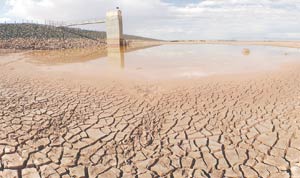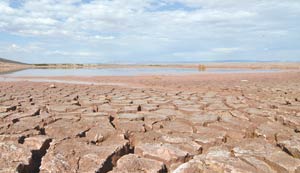'The dream just ended'
Many Farms elders reminisce about wetter days
By Larissa L. Jimmy
Navajo Times
MANY FARMS, Ariz., July 11, 2013


(Times photo – Donovan Quintero)
TOP: What remaining moisture that is left in the soil is sucked dry by the hot summer sun and forming cracks in the ground on Monday at Many Farms Lake in Many Farms, Ariz.
SECOND FROM TOP: A dried up tree branch stands out in the middle of where Many Farms Lake used to be on Tuesday in Many Farms.
T here are about 5,000 lakes and ponds on the Navajo Nation, but for the elders of Many Farms, there is only one: Many Farms Lake, also known as To'ahidiilíinii (Water that Comes Together).
Today, Many Farms Lake is nothing more than an abandoned murky pond with no fish, useful only to dragonflies. But according to the Navajo elders in the area, the lake once thrived with vegetation and was stocked with fish.
Only a week after President Ben Shelly declared the Navajo Nation in a state of drought emergency, sprinkles managed to fall lightly onto the dried cracks of the lake's skeletal floor, which looks like ancient cobble stones. Unfortunately, the sprinkles only lasted a moment.
But talking with the elders puts this sad situation in perspective.
The irony is that this once-bountiful lake started off as a pond until it eventually became bigger with the help of surrounding washes.
There are about four washes that connect with the lake - Chinle, which feeds the lake the most; Jimson Weed Wash; Ghad Tiszhini Wash and Sheep Dip Wash, according to Many Farms officials.
David Charles, born and raised in the area, said, "People would come from all over to fish" for its big catfish, trout, and bass.
Many Farms Lake is now murky and muddy. Before, it used to be clear and clean; even clean enough to drink from, according to some of the locals.
"The moon could reflect off the lake," says Charles, "but now it's red."
The 72-year-old grew up about a mile from the lake. He smiles as he explains how his family loaded up their family wagon with chunks of ice during the wintertime. The ice, according to Charles, was thawed and used for drinking water, something no sane person would consider today.
A variety of birds flourished in the area.
"There were cardinals, bluebirds, shiny black birds with white specks, but now there are (just) crows," Charles says.
Thick blue clouds hover over the remains of the lake, evidently not enough to block out the sun because soon after the shower, sun rays beamed here and there.
"Back in those days, it wasn't this hot," Charles said. "It was cooler. Nowadays, it's very hot."
In addition, Charles said he has noticed a change in the climate: less rain and snow, higher temperatures and continuous winds.
Seventy-four-year-old Helen Olson Chee says that when she was about six years old, her dad Joseph Olson helped build the dam that formed the reservoir.
According to Roland Tso, the grazing official for Many Farms Chapter, about $2 million was lobbied from the state to rehabilitate the dam, also known as the "Diversion Dam." That same dam now has a waterline discoloration from south to north, the only evidence that there was ever water in the lake.
According to Olson, in recent times, the dam had undergone reconstruction to increase the lake's water levels and additional rocks were added for reinforcement. Although, to Olson, the result was unsuccessful, "To eh ohaheyoniídeh aahahii o aas diín" ("There used to be a lot of water, now there's no more").
"Last year there was water. This year there is none. About two years ago, people stopped planting because of the water," Charles says.
When Many Farms Lake would swell with the rain and melted snow, the water from the lake would irrigate and moisten the land, which local farmers would then use for planting. There was an abundance of corn, squash, watermelon, cantaloupe, sunflower seeds, and cucumbers that once congested the north side of the lake. Olson says the farmers came as far away as Rough Rock to plant in the moist soil.
It was hard work, though
Community member Susan Olson, 53, recollects the strenuous labor demanded from farmers for the vegetation around the lake.
"They didn't use tractors back then. They used horses, mules and plows," says Olson. "It was manual labor."
Olson describes the mules as fast-walking animals and said that farmers would have to be quick in following the creatures while planting seeds in the soil. Vegetation is also thick around the artesian well, which can be found nearby among what locals call "monkey egg trees." This alternative source of water, too, has begun to slowly deplete.
In addition, Charles said that because of the drought, fish that once populated the lake were being found in farm fields either alive or dead.
"Yesterday, I went there and I couldn't believe it," said Charles, shaking his head. "There were whirlwinds coming from the lake. I couldn't believe that all the water was gone. I heard about it, but I didn't think that it was gone completely."
According to Many Farms Chapter Secretary-Treasurer Lucy Ayze, the chapter has been trying to replenish the farm lands, but that could take years.
"I remember when this whole place was overstocked and Many Farms at one time thrived," said Ayze.
Marlene Thomas, 56, a community member, said Many Farms Lake almost dried up before, back in 2000, but in that case it was intentional, unlike the current situation.
"Some people wanted to drain the water from the lake and use it as irrigation for their cornfields, but it didn't happen because some people didn't want that to happen," says Thomas.
Since the Navajo Nation's drought declaration, the evidence continues to grow that many communities are being severely affected. The elders in the Many Farms community may only find comfort in their memories of what used to be.
"It seems like the dream just ended," said Charles. "Is it ever going to rain again or will there be water in that lake again? I don't know."

